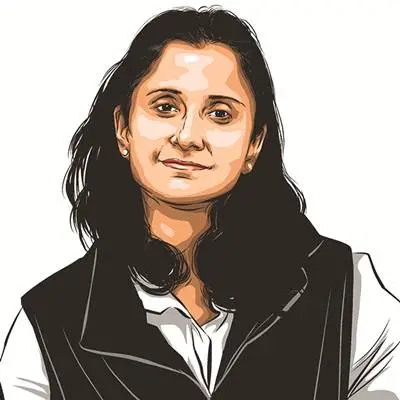Opinion Jasleen Kaur’s Turner Prize win: Art that probes identity, history and heritage
The world now is much more interconnected than it was when Indian modernists travelled to the West, returning with a transformed perspective on India. For the current generation of diasporic artists, their artistic lens is shaped by a profound urge for inward reflection
 While accepting the Turner prize, Kaur, 38, reflected that she lacked “cultural access” while growing up, but the landscape has changed since. (David Parry/PA Media Assignments)
While accepting the Turner prize, Kaur, 38, reflected that she lacked “cultural access” while growing up, but the landscape has changed since. (David Parry/PA Media Assignments) Announcing Indian-origin Scottish artist Jasleen Kaur winner of the 2024 Turner Prize, the jury “praised her ability to gather different voices through unexpected and playful combinations of material”. Their references alluded to Kaur’s distinctive art practice marked by a rich tapestry of diverse influences and fluid cultural identities.
Born and raised in Glasgow, Kaur’s childhood was shaped by a household where traditions were both preserved and cherished. Her great-grandfather had migrated from Punjab to the United Kingdoms in the 1950s but the ties with the homeland remained strong. “An artist making with the slurry of life. Raised amidst betrayal, secrecy and banished outsiders, her work is to make sense of what is out of view or withheld. She is called towards plurality, declassifications, polyphony, the blur,” is how Kaur’s website describes her.
This complex cultural fusion perhaps is most poignantly expressed in her work, where autobiographical elements come together with her quest to reconnect with her personal heritage across continents. For her degree show at the Royal College of Art in London in 2010, she created “Chai Tea Stall”, a mobile tea stall featuring small clay cups. Exhibited as a conceptual art piece, for her community, it was also a familiar touchstone — Kaur’s way of bringing the tea-drinking street culture of India to the UK. Her 2016 solo “The Tending of Something” questioned boundaries between art and craft; for the 2021 filmed performance piece “Gut Feelings Meri Jaan”, she invited residents of Rochdale to respond to the “ethnic minorities” section of the local history archives at the Touchstones Museum and Art Gallery.
The series that earned her the prestigious Turner Prize, “Alter Altar”, probes her upbringing in Scotland as part of an Indian family. By reimagining everyday objects and imbuing them with renewed significance, her work challenges conventional perspectives and celebrates alternate modes of perception. Worship bells feature prominently in a series of kinetic sculptures, while the Scottish Irn-Bru soda bottles evoke memories of the gurudwara meals she cherished. The harmonium — an instrument on which she learned devotional music from her father — is placed on the floor, evoking a sense of personal history. The centrepiece that captivated considerable attention is a red Ford Escort, draped with a hand-crocheted doily. While the car symbolised her father’s first vehicle and his migrant aspirations, the four-meter doily powerfully linked material culture to the legacies of the British Empire, cotton trade, and migration of labour from the colonies to the British textile mills after World War II. Playing in the background were soundtracks that shaped her childhood, ranging from the Sufi music of Nusrat Fateh Ali Khan to the reggae rhythms of Bob Marley, blending her influences in a rich auditory landscape.
While accepting the Turner prize, Kaur, 38, reflected that she lacked “cultural access” while growing up, but the landscape has changed since. She continued, “I have had so many messages today from people from the local Sikh community and from folk that I grew up with… Something like this that is so visible means a lot to a lot of different people… It means something to different groups and I’m up for representing all of them.”
The world now is much more interconnected than it was when Indian modernists travelled to the West, returning with a transformed perspective on India. For the current generation of diasporic artists — several of whom belong to second-or third-generation migrant families — their artistic lens is shaped by a profound urge for inward reflection. They aren’t a cohesive band, but their common urge to explore their diasporic identities knits them together. Kaur’s win is also their win, not because she embodies every aspect of their experiences, but because she is one of them. It is anticipated that her recognition will spark greater interest in the themes they explore. Together, they embody a broader, evolving conversation about race, heritage, and the complexities of contemporary identity.
The jury — chaired by Alex Farquharson, director, Tate Britain — applauded Kaur for the “considered way” in which she “weaves together the personal, political and spiritual”. Her moment of triumph was a natural extension of this approach. Dressed in colours of the Palestinian flag, she made a powerful call for a ceasefire in the Middle East, voicing her solidarity with the protesters gathered outside the venue. She also called for an end to institutional complicity in Israel’s war on Gaza, and an arms embargo. One of the signatories to a letter demanding that Tate sever ties with organisations that are deeply complicit with the Israeli regime, she added, “It’s not a radical demand… This should not risk an artist’s career or safety.”
vandana.kalra@expressindia.com





